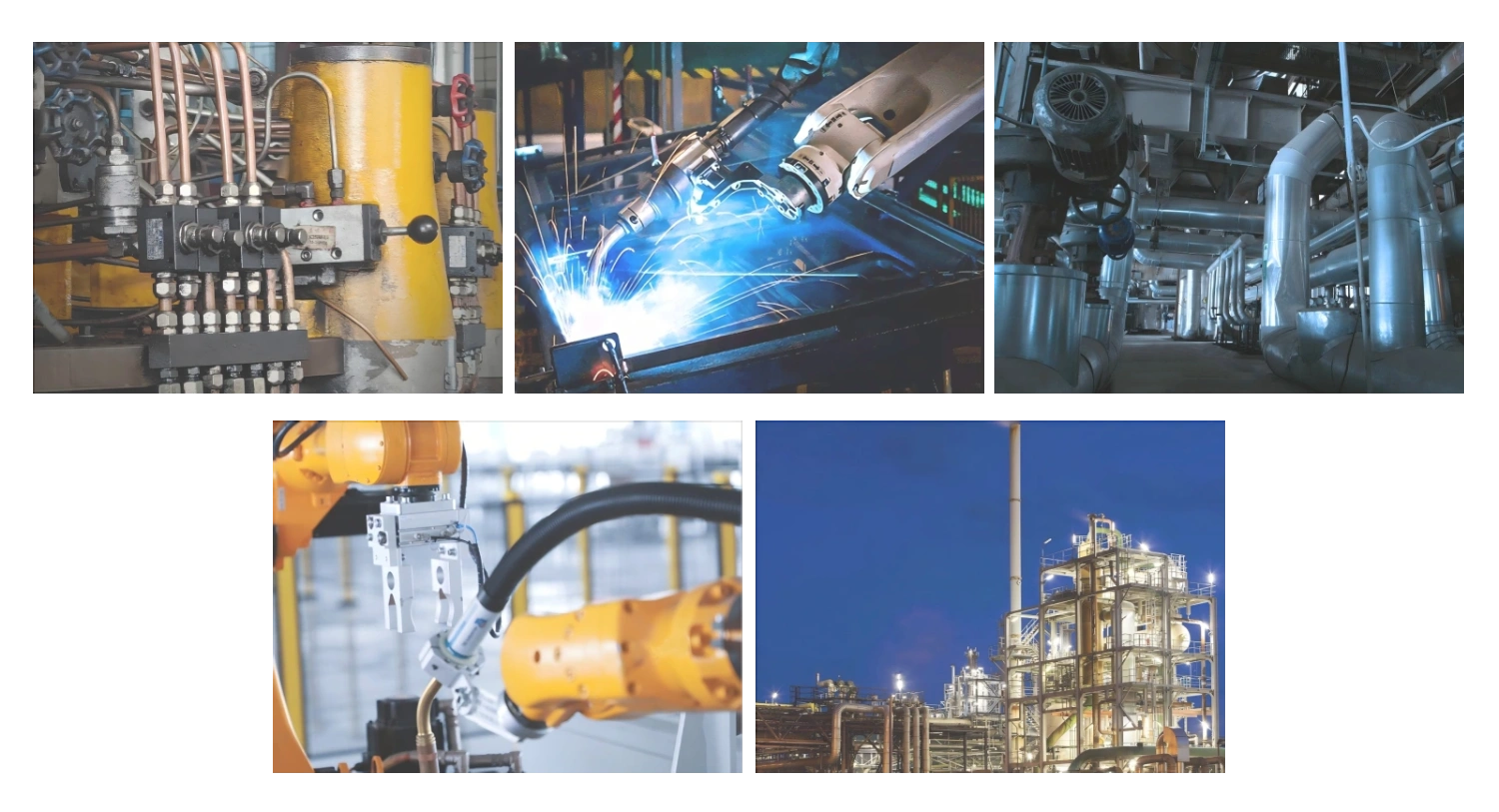Understanding Automotive O-Ring Material Options
When you're selecting the right O-ring for automotive applications, it's important to understand the different material options available. Various materials offer distinct properties that make them suitable for specific applications within the automotive industry. Let's delve into the key materials used in automotive O-rings and their respective advantages.
Nitrile (NBR) for Fuel and Oil Resistance
Nitrile (NBR) is well known for its outstanding resistance to oils and fuels, so it is widely used in the automotive industry. This material is not only versatile, but works well against temperatures ranging from -30°C to 100°C, and is one of the only materials that performs well against low temperatures, hydrocarbon based applications, high temperatures or abrasion. Key industrial markets for NBR are automotive and aeronautical. Major industrial applications for NBR are gaskets, rollers, fuel hoses, and other products in which oil resistance is required. So it makes NBR is good to choose for rubber ring clips and cutting the rubber gasket in engines and fuel system where to beexcellent in oil resistant and live long.
Silicone for Extreme Temperature Stability
Silicone 'O' Rings are ideal for applications where temperature variation is severe. Since silicone can withstand temperature extremes from -60 C to 230 C, it is durable in even the most extreme environments. The flexibility of the material at low temperatures guarantees that the seal is maintained as other materials fail, especially at the elevated temperatures seen in bagmaking applications. Studies have shown that silicones O-Rings are durable – boschtech Silicone O-Rings are a reliable solution for challenging applications. This is of particular importance for items like the rectangle waterproof silicone gaskets required in applications that are subject to harsh fluctuating temperatures and conditions.
Fluorocarbon (Viton) for Chemical Durability
Fluorocarbon O-Rings, like Viton are able to withstand high and low temperatures, with a working temperature range of 5 F to 400 F Degrees. Viton O-Rings have a temperature range of -20°C to 200°C and are used in the automotive industry and in other applications which require resistance to a range of chemicals. Industry reports indicate that Viton can increase the life of seals in harsh environments. This makes them especially useful when standard rubber will not perform, as with o-rings and o ring brass nipples used in chemical and heat exposure situations. This has made them a very attractive sealing solution for long-life in automotive applications.
Assessing Chemical Compatibility in Automotive Fluids
Brake Fluid and Coolant Exposure Considerations
When choosing O-Ring materials, it is important to consider their compatibility to brake fluids, which may be glycol or silicone based. Research has shown that incompatible materials can swell, harden or split and may result in system failure. (All O-Rings are NOT created equal) When recommending components for use in brake fluid, it is necessary for the manufacturer to recommend O-Rings rated for automotive brake systems to offer longevity and reliability.
Resistance to Petroleum-Based Lubricants
As petrolatum based greases lubricates many automotive applications, O-Rings needs to be resistant against those too. Petroleum resistance varies with the different types of elastomers, if you want to make those seals work well, choosing them correctly is necessary. Although resistance varies with different materials, NBR is generally recommended as the optimum choice for resistance to hydrocarbon media.
Impact of Ethanol-Blended Fuels on O-Rings
Many areas use ethanol in fuel, but O-Rings not specifically designed for such exposure may fail. Studies have demonstrated that rubber O-rings can swell and lose sealing performance in fuels such as E100 (100% ethanol). Choosing O-Rings that are designed to be resistant to ethanol is critical to avoiding such potential failures in operation as a result of fuel incompatibility. Selecting the right material can enable automotive systems to withstand the most severe fuel environments.
Temperature and Pressure Requirements for Vehicle Seals
Engine Compartment Heat Tolerance
O-Rings working in an engine compartment are required to withstand permanently elevated temperatures, sometimes up to more than 120°C temperature which is generated by an intensive heat of engine. Appropriate selection of materials is crucial in order that these components are capable of surviving such temperatures without degrading. For example, both silicone and fluorocarbon rubber materials are known to have excellent heat resistance and can therefore be used advantageously for automotive applications. Performance testing: There are data that suggest the effectiveness of these materials and that their integrity keeps them in place during extreme heat. Materials selection is also important to achieve the durability of the O-Ring and to secure the reliability of the vehicle.
Dynamic vs. Static Sealing Applications
When choosing O-Rings, be careful to make a difference between a dynamic and static usage. O Rings that are part of dynamic (moving) applications are commonly exposed to various forms of damage, including abrasion or extrusion to maintain a seal. Static seals typically have less mechanical pressure exerted on them, so it is important to be mindful of pressure differentials and the sealing environment. Various engineering principles approach the selection of materials for dynamic and static applications. By knowing what each type of application require, we can help optimize the material and the life of the seal.
Managing Compression Set in Rubber P Clips
Compression set is the inability of rubber to recover its original form following compression, a key element in seal performance. Ongoing evaluations show that a low compression set is one of the key factors for increasing the service life of sealing applications. It is of particular importance for use with rubber P clips where sealing is critical. Many professionals will recommend selecting rubber compounds with low compression sets in an effort to enhance the O-Ring's service life. The use of the proper compounds can greatly improve sealing performance and service life for a widerange of applications.
Proper Sizing and Measurement Techniques
Cross-Section Diameter for Waterproof Silicone Gaskets
It's important to be precise when using waterproof silicone gaskets in order to have a perfect seal fit. The industry norm is that even minor variations in these dimensions can lead to leaks, particularly when they are encountered in high pressure applications. Therefore, the use of accurate measuring devices is crucial to avoid errors during installation and to guarantee a proper sealing of the gasket. High measuring accuracy tools are recommended for optimal sealing in waterproof applications.
Gland Design for Brass Nipple Fittings
In the case of brass nipple fittings, the design of the gland is a key feature to ensure good sealing. The correct sizing of glands will increase the operating efficiency of rubber O-Rings Packed in those glands and will increase the sealing capabilities. Conforming to construction dimensions is crucial; deviations can result in a severe pressure loss and leakage risk. One such problem can be avoided and reliable sealing results can be obtained by observing accurate dimensional criteria.
Avoiding Leaks with Accurate Inner Diameter
Accurate measurement of O-Ring inside diameter is essential to proper fit and function. It is shown from research that incorrect sizing is the most common cause for O-Ring failure, making accurate precursor measurements crucial. For absolute IMPORT O ring sizing accuracy, many industry professionals prefer using GO NO GO type tooling such as a set of dial calipers or specialized O-Ring sizing instruments, but we wanted to offer something that would yield us in the "average" size instead. These products offer the exacting precision required to get perfect seals and circumvent typical sealing hazards.
Installation Best Practices and Common Pitfalls
Preventing Twisting During Assembly
Minimization of the O-Ring resistance to twisting is essential to obtain the longest life and maximum reliability of O-rings. O-Rings are twisted during installation, which causes premature failure. To reduce these risks, I find alignment methods or tools are helpful in preventing twist. Most manufacturers have very well defined installation guides and it does mention to handle them with care and ensure they are pushed in and aligned in a certain orientation to avoid tearing them apart during the installation stages. These can be really useful, especially in preventing the seal from breaking.
Lubrication for Ring Rubber Clip Retention
Lubrication is instrumental in retaining and increasing the life of the rubber clip during the installation process. Studies have reported that using compatible lubricants can not only prevent material damage but also lead to smoother assembly operations. Lubricants should be tested with the O-Ring material to determine their compatibility with the O-Ring material and the medium it will be used in. Professionals emphasize that the appropriate lubricant can ease installation and help avoid problems in the future. *The usage of high quality lubricant, however, can make a difference between them lasting or having to purchase a new one prematurely.
Post-Installation Inspection Protocols
It is advisable to perform a careful post-installation check in order to guarantee the life and performance of the seal. Visual examination for misalignment, compression set and appearance of wear is recommended in these inspections. It would be nice to know which have life left in them and which we should scrap or fix?;;; Protocols have been set and "best practices" dictate that we need to audit these items at regular intervals so that we can catch the faults before they fail in the field. In complying with these testing practices, I am able to make certain that the seal is durable and will not fail prematurely, offering superior performance for its duration of service. Scheduled checks can help catch any small problems before they become fully fledged system failures.
Each section above considers the critical aspects of O-Ring installations, ensuring O-Ring success from start to finish, minimizing risks such as twisting, ensuring proper lubrication, and establishing a robust post-installation inspection protocol to protect seal integrity.







